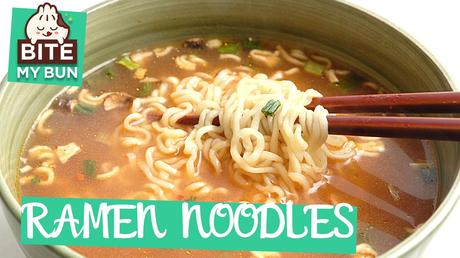Because ramen is an alkaline noodle, it’s not quite the same thing as pasta. If you think about Italian-style pasta like spaghetti, you’ll notice that it is straight whereas ramen noodles are squiggly.
But you can use classic pasta dough to make a kind of ramen too. With an automatic or manual pasta maker serving as a ramen machine, you can make home-style ramen noodles.
You should use the angel hair pasta attachment or add baking soda to spaghetti dough for a similar effect and texture.

Baking soda gives noodles that alkaline flavor ramen is associated with.
Ramen and pasta are very different mind you, but you can make some delicious Asian noodles with the right dough.
Minestrone: Tiny Pasta
Traditional Italian dried pasta made with semolina and wheat is the perfect match for hearty broth-based soups like minestrone and pasta e fagioli.
Smaller shapes such as pipette elbows miniature farfalle and orzo work great for soup containing large quantities of vegetable stock.
If you can’t find Asian noodles, which I recommend you try to do, minestrone is a good bet.
Ramen noodles – What do they do?
Wheat grains contain unusually high levels of protein, around 31% of their overall nutrient content. Kansui is water that is high in alkaline or lye having a unique mixture of potassium carbonate and sodium carbonate.
The alkaline substances present in the kansui are absorbed through the noodles which results in its distinctive ramen character.
This gives the noodles also a much more shiny appearance and gives them a slightly yellowish finish.
It is good food if you’re a vegetarian who wants to build muscles or if you’re a professional who works out and wants a simple protein dish at the end of a gym session.
Also read: this is the Japanese version of delicious pasta wafu pasta
Different breeds of ramen noodles
You can buy many different kinds of noodles with diverse variations in their textures and consistencies: thin and stringy to thick and chewy.
Ultimately this choice will depend on the taste you use for the ramen. The amount of water added to the noodles during an application will affect your noodle’s texture and composition.
The water percentage influence the final ramen morphology, texture, and even taste naturally. A lot of water is necessary with a softer noodles ratio while less water gives you that distinctive crunch.
The next time You go buying noodles, check it’s water consistency.
Every bowl of ramen should be crafted around the best wheat-based ramen
A bowl of the noodles soup must contain gluten-free, alkaline grains. The noodles are also the only constant in the rich and varied world of ramen.
If you want the best noodles your best bet is that you bought them from a noodle manufacturer such as Sun Noodle or Shimamoto Noodle.
The home cook looking to experience the great world of alkaline noodles we have found a basic recipe that’s relatively simple to make and uses most typical ingredients and equipment.
This recipe is intended to illustrate that making alkaline ramen is not only able but also rewarding.
Best noodles for Ramen
Traditional ramen noodles are made from wheat flour, water and kantsui commonly referred to as lye water. These alkaline water solutions make them slippery and shiny.
Udon noodles are Japanese noodles made from wheat flour. Rice vermicelli noodles have the same thickness as angel hair pasta only slightly larger. Shiraki Noodles are for anyone who loves low-calorie, no gluten low carbohydrates & zero carbs.
These noodles are sometimes called “Magical Noodles” because they are very filling while also containing little calories.
Also check out these great ramen machines to make your own ramen pasta dough
